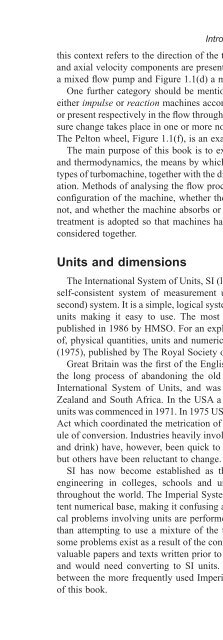Fluid Mechanics and Thermodynamics of Turbomachinery, 5e
Fluid Mechanics and Thermodynamics of Turbomachinery, 5e
Fluid Mechanics and Thermodynamics of Turbomachinery, 5e
You also want an ePaper? Increase the reach of your titles
YUMPU automatically turns print PDFs into web optimized ePapers that Google loves.
this context refers to the direction <strong>of</strong> the through-flow at rotor outlet when both radial<br />
<strong>and</strong> axial velocity components are present in significant amounts. Figure 1.1(b) shows<br />
a mixed flow pump <strong>and</strong> Figure 1.1(d) a mixed flow hydraulic turbine.<br />
One further category should be mentioned. All turbomachines can be classified as<br />
either impulse or reaction machines according to whether pressure changes are absent<br />
or present respectively in the flow through the rotor. In an impulse machine all the pressure<br />
change takes place in one or more nozzles, the fluid being directed onto the rotor.<br />
The Pelton wheel, Figure 1.1(f), is an example <strong>of</strong> an impulse turbine.<br />
The main purpose <strong>of</strong> this book is to examine, through the laws <strong>of</strong> fluid mechanics<br />
<strong>and</strong> thermodynamics, the means by which the energy transfer is achieved in the chief<br />
types <strong>of</strong> turbomachine, together with the differing behaviour <strong>of</strong> individual types in operation.<br />
Methods <strong>of</strong> analysing the flow processes differ depending upon the geometrical<br />
configuration <strong>of</strong> the machine, whether the fluid can be regarded as incompressible or<br />
not, <strong>and</strong> whether the machine absorbs or produces work. As far as possible, a unified<br />
treatment is adopted so that machines having similar configurations <strong>and</strong> function are<br />
considered together.<br />
Units <strong>and</strong> dimensions<br />
Introduction: Dimensional Analysis: Similitude 3<br />
The International System <strong>of</strong> Units, SI (le Système International d’Unités) is a unified<br />
self-consistent system <strong>of</strong> measurement units based on the MKS (metre–kilogram–<br />
second) system. It is a simple, logical system based upon decimal relationships between<br />
units making it easy to use. The most recent detailed description <strong>of</strong> SI has been<br />
published in 1986 by HMSO. For an explanation <strong>of</strong> the relationship between, <strong>and</strong> use<br />
<strong>of</strong>, physical quantities, units <strong>and</strong> numerical values see Quantities, Units <strong>and</strong> Symbols<br />
(1975), published by The Royal Society or refer to ISO 31/0-1981.<br />
Great Britain was the first <strong>of</strong> the English-speaking countries to begin, in the 1960s,<br />
the long process <strong>of</strong> ab<strong>and</strong>oning the old Imperial System <strong>of</strong> Units in favour <strong>of</strong> the<br />
International System <strong>of</strong> Units, <strong>and</strong> was soon followed by Canada, Australia, New<br />
Zeal<strong>and</strong> <strong>and</strong> South Africa. In the USA a ten year voluntary plan <strong>of</strong> conversion to SI<br />
units was commenced in 1971. In 1975 US President Ford signed the Metric Conversion<br />
Act which coordinated the metrication <strong>of</strong> units, but did so without specifying a schedule<br />
<strong>of</strong> conversion. Industries heavily involved in international trade (cars, aircraft, food<br />
<strong>and</strong> drink) have, however, been quick to change to SI for obvious economic reasons,<br />
but others have been reluctant to change.<br />
SI has now become established as the only system <strong>of</strong> units used for teaching<br />
engineering in colleges, schools <strong>and</strong> universities in most industrialised countries<br />
throughout the world. The Imperial System was derived arbitrarily <strong>and</strong> has no consistent<br />
numerical base, making it confusing <strong>and</strong> difficult to learn. In this book all numerical<br />
problems involving units are performed in metric units as this is more convenient<br />
than attempting to use a mixture <strong>of</strong> the two systems. However, it is recognised that<br />
some problems exist as a result <strong>of</strong> the conversion to SI units. One <strong>of</strong> these is that many<br />
valuable papers <strong>and</strong> texts written prior to 1969 contain data in the old system <strong>of</strong> units<br />
<strong>and</strong> would need converting to SI units. A brief summary <strong>of</strong> the conversion factors<br />
between the more frequently used Imperial units <strong>and</strong> SI units is given in Appendix 1<br />
<strong>of</strong> this book.

















